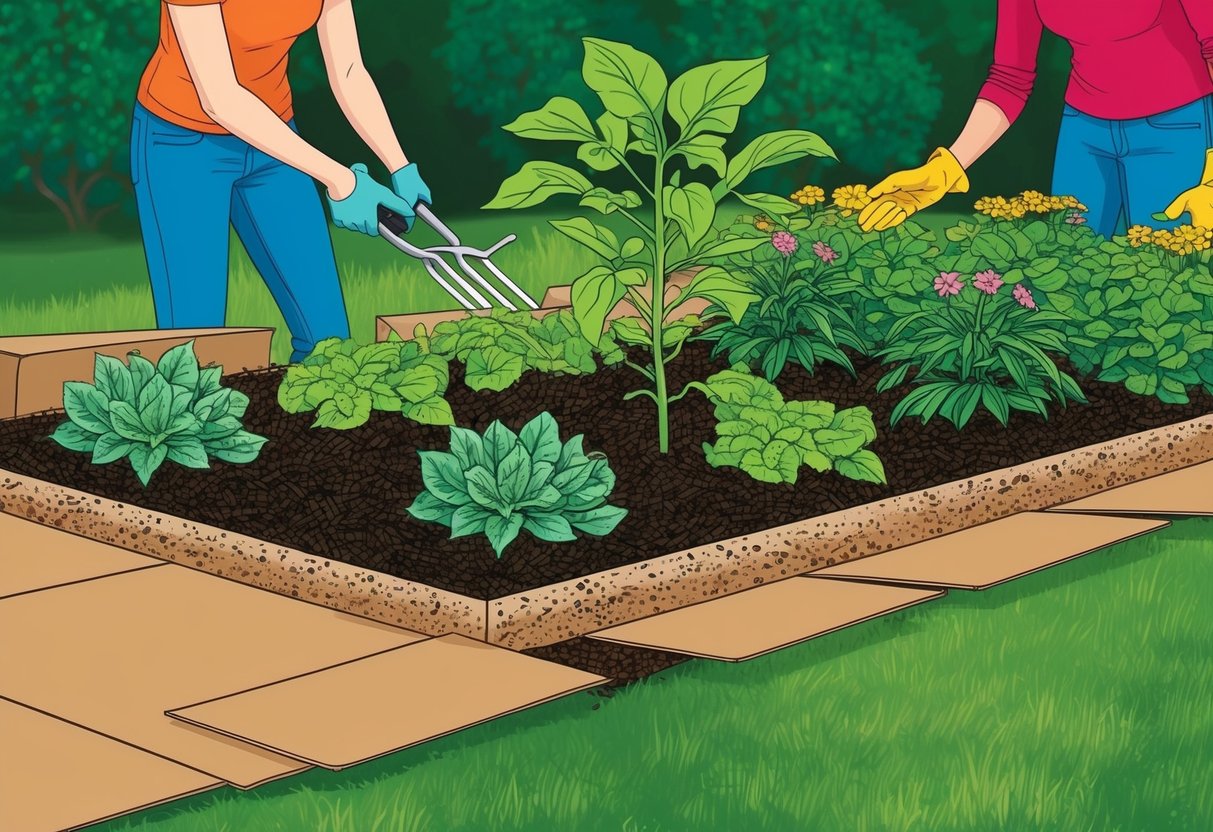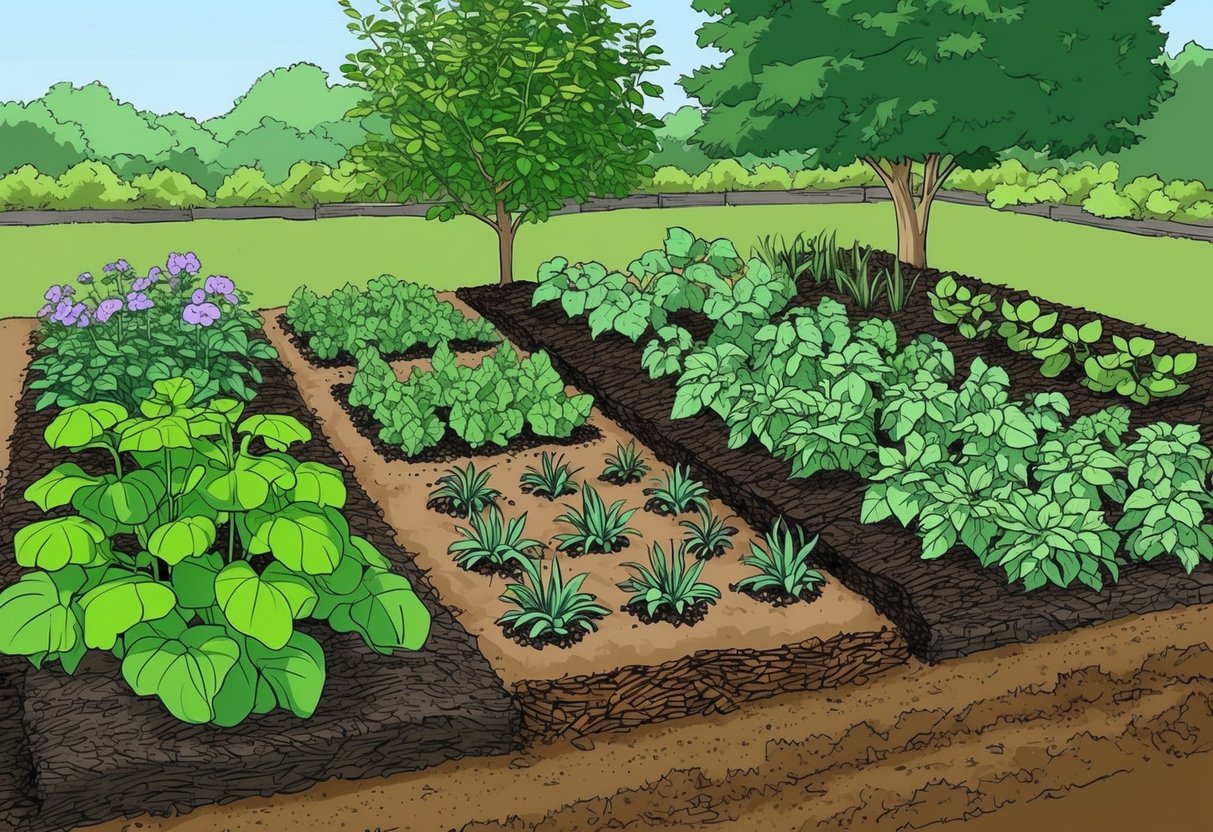
Pest and Disease Management
No-dig garden systems promote healthier soil biology, which naturally suppresses many soil-borne pests and illnesses. Encouraging beneficial insects and using physical barriers, like netting or row covers, reduces the need for synthetic pesticides.
Crop rotation is vital for breaking pest and pathogen cycles. Planting disease-resistant varieties and removing infected plant debris limits the spread of common problems.
Maintaining mulch depth discourages pest migration and protects plant roots. Organic gardening methods such as neem oil sprays, diatomaceous earth, and companion planting help address specific issues.
Regularly inspecting plants for damage and acting quickly can prevent minor problems from becoming major infestations.
Monitoring Soil Health
Soil health forms the foundation of a successful no-dig surface. Gardeners should assess key indicators such as texture, moisture retention, and the presence of earthworms.
Observing how well the soil crumbles, checking moisture a few inches below the mulch layer, and looking for organic matter can reveal overall quality and biological activity. Conducting simple soil tests for pH and nutrient levels helps track any deficiencies.
Organic amendments like compost or aged manure replenish nutrients and keep the soil balanced. Maintaining a regular mulching routine adds protection, preserves moisture, and fosters a microbiome that supports long-term fertility.
Tip: Incorporate organic matter rather than synthetic fertilizers to sustain a healthier ecosystem and minimize disruption to soil structure. Explore step-by-step advice on this topic in no-dig gardening guides.
Seasonal Adjustments
Adapting no-dig gardening practices to seasonal changes is essential for plant vigor. In spring, increase compost layers to support rapid plant growth and suppress early weeds.
During summer, thicker mulching conserves soil moisture, especially in periods of drought or high heat. As the growing season ends, remove spent crops and add a cover of organic mulch or cover crops to shield bare soil from erosion and support decomposer organisms through winter.
In mild climates, continue adding layers of organic matter throughout the year, while in colder regions, protect beds with straw or leaf mulch. Adjust watering, mulch thickness, and compost inputs based on weather, crop needs, and natural rainfall patterns.
Supporting a Thriving Garden Ecosystem
A resilient no-dig garden is maintained by supporting natural processes and garden biodiversity. Encourage the presence of earthworms, beneficial insects, and pollinators by avoiding chemical pesticides and fostering diverse plantings.
Companion planting and perennial flowers can provide food and shelter for helpful wildlife. Leave some garden debris to decompose, as it becomes habitat for soil organisms and returns nutrients to the bed.
Practicing crop rotation and integrating native plants further enhance the organic gardening ecosystem, reducing pests and balancing the microenvironment. Maintaining diverse living organisms, healthy plant cover, and a consistent organic matter supply helps the entire garden system remain robust through each growing season.
More details on fostering ecosystem health in no-dig beds are available in expert no-dig gardening guides.
Frequently Asked Questions

No-dig gardening methods reduce soil disruption, help retain soil structure, and often improve drainage while saving time and physical effort. Success depends on proper layering of organic materials, thorough weed suppression, and consistent use of mulch.
What are the common limitations or disadvantages of no-dig gardening?
The initial setup can require large amounts of organic material, which may be costly or time-consuming to source. No-dig beds may also need more frequent topping up with compost or mulch, especially in the first few years.
Some pests, like slugs, can thrive under thick mulches, so regular monitoring is needed. Perennial weeds can persist if not thoroughly suppressed at the start.
What steps should beginners take to start a successful no-dig garden?
Beginners should begin by choosing a sunny, well-drained site and removing or flattening any tall weeds or growth. Cover the area with a thick layer of cardboard to smother remaining weeds, then add at least 4–6 inches of well-rotted compost or organic material.
Water the layers thoroughly after setting them up. For more detailed advice, Stephanie Hafferty’s no-dig garden FAQ offers helpful starting points.
How can cardboard be used effectively in no-dig gardening?
Cardboard acts as an organic weed barrier that gradually breaks down and feeds soil microorganisms. Lay sheets of plain, uncoated cardboard directly on the soil, overlapping the edges to prevent weeds slipping through the gaps.
Keep the cardboard moist and immediately cover it with compost or mulch to hold it in place and jumpstart decomposition. This method is both eco-friendly and effective for weed suppression, as shown in many no-dig gardening guides.
What are typical mistakes to avoid when setting up a no-dig garden?
Some common mistakes include using too little compost or mulch, leaving gaps in the cardboard layer, or using cardboard with plastic coatings or tape still attached. Avoid starting with poor-quality or unfinished compost, which can bring in weed seeds or pathogens.
Not overlapping cardboard properly can allow weeds to rebound. Regular maintenance is necessary to keep weeds at bay in the early years.
How much mulch is required to adequately cover a no-dig garden?
A typical no-dig bed requires 4–6 inches of mulch or organic compost for good weed suppression and nutrient retention. For larger or weedy areas, thicker layers may be needed.
Adding additional mulch each season helps maintain soil health and continues to feed soil organisms, according to recommendations from Epic Gardening.
Is it possible to create a no-dig garden without using compost, and if so, how?
No-dig gardening is possible without traditional compost by using materials such as well-rotted manure, leaf mold, grass clippings, or even straw. These alternatives often require longer to break down.
Layering a variety of organic materials can mimic the benefits of compost in a no-dig setup. This makes it adaptable for gardens with limited compost supply.